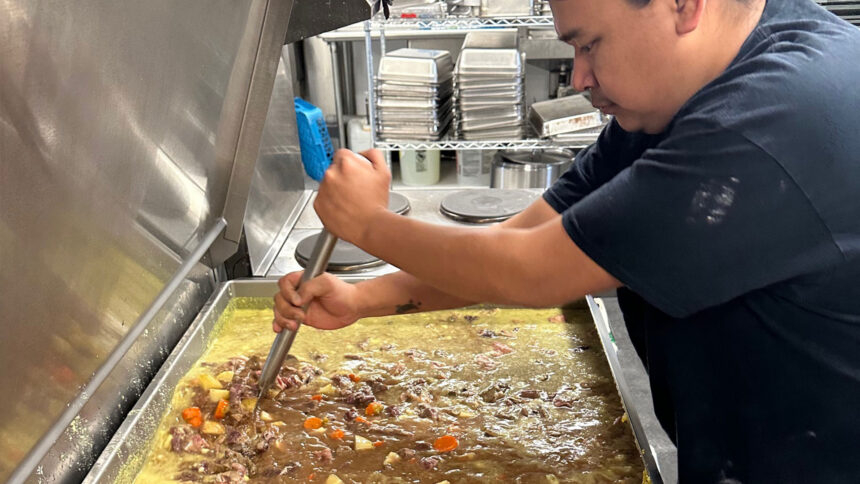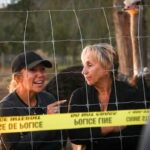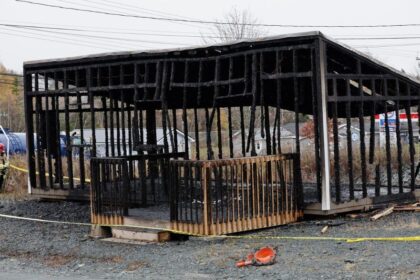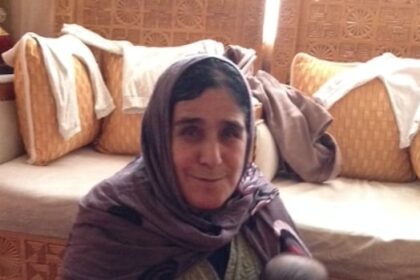A few weeks ago, in Pond Inlet, Nunavut, Rhoda Katsak’s son shot two seals, one small and one large. He brought them home and the family enjoyed the small seal. “A young seal, or a smaller seal, is more delicate,” Katsak told APTN News. “They have more tender meat.” The first seal lasted days and then they turned to the larger one. It was a challenge, because meat from a big seal is not nearly as pleasant to eat. Katsak says her husband suggested they put a notice on Facebook that they had a large seal available and people could come get some meat for dog food. They didn’t expect anyone to want to eat it themselves. “It wasn’t something that we would normally give to anybody in general because it’s not a choice of meat, for our age group anyway,” she says. “In ten minutes, it was gone. People came to pick up meat. They really didn’t care. They wanted the food.” For Katsak, it was an indicator of how desperate members of her community had become for access to food, especially traditional food. Her experience is not unique. All across Nunavut, local experts say Inuit are struggling with hunger. The northern hunger emergency Hunger in Nunavut is not a new challenge, says Dr. Jessica Penney. “[It’s] an issue that we’ve seen increasing in recent years, but that is so longstanding. The statistics on food insecurity in Inuit communities have been abysmal for many years,” she says. Penney, a Nunatsiavut Inuk who grew up in Iqaluit, is a postdoctoral fellow at the University of Toronto. Over the past three years, she participated alongside Katsak in a project called Inuksiutit: Food Sovereignty in Nunavut, run by the Canada–Inuit Nunangat–United Kingdom Arctic Research Programme (CINUK). Penney was a co-investigator for the Inuksiutit project, and so was Katsak, who was raised partially on the land, attended federal day school and eventually served as regional director of economic development for the government of Nunavut from 2005 and 2020. Centering on the communities of Pond Inlet/Mittimatalik and Arviat, the project sought to determine key factors in food sovereignty and to educate Inuit about how to better access country food. Following the project’s completion, Penney led the development of Yellowhead Institute’s Inuksiutit Toolkit, which shaped information from the Inuksiutit project into an interactive pathway called Story of the Seal, exploring the seal’s crucial role in the culture of Inuit communities. The threat of food insecurity was the driver both for the Inuksiutit project on its own and also for Yellowhead Institute to develop the project’s information into an interactive learning experience. The Inuksiutit Toolkit features “Masterclass” videos from the greater Inuksiutit project, in which Katsak and her husband teach traditional techniques of hunting and butchering seal, caching seal meat for fermentation, preserving meat in sealskin and cooking every part of the seal in traditional manners. Fresh seal, from country-food hunting instructional videos prepared by Rhoda and Joshua Katsak with Inuksiutit project. Photo: Rhoda Katsak Iqaluit-based Dr. Amy Caughey, another co-investigator with Inuksiutit, is a public-health nutritionist with decades of experience in Nunavut. She’s studied the role of Inuit country food in the community and its connection to health in early life. Caughey explains the difference between “food security,” the state of being able to access food, and “food sovereignty,” the state of being able to eat culturally relevant food people enjoy eating and want to eat. “It’s a very important distinction,” Caughey says, “and within Nunavut, what Inuit organizations have expressed [and] Inuit health workers have said [is] that food sovereignty and food security means having access to country food and the country food system.” The absence of country food, Caughey says, is a key feature in food insecurity, which she also tied to the high cost of food in stores. “People who are food insecure are more likely to be unhealthier,” Caughey explained. “They’re more likely to experience infectious disease, poor oral health, chronic disease, and mental health challenges. They’re admitted to hospital and stay longer in hospital. “And what we know in Nunavut is we have a significant challenge with food insecurity for both adults and children. That goes on to many of the other challenges that we have. For instance, tuberculosis. A huge component of tuberculosis is actually the home you live in, the food you have access to. There are many, many things linked to food insecurity.” Caughey says the Inuksiutit project aimed to use Inuit knowledge of country food systems to challenge food insecurity while bolstering community health and connections with traditional cultures. “Country food is linked to positive mental health and to connection to community and all these very powerful concepts that we consider to be really good things,” she says. “Within Nunavut, it’s especially important because when we’re talking about country food, it’s of course very closely linked to animals and humans and the environment and where all those things come together.” Youths in Pond Inlet, NU, learning to cache seal meat for fermentation. Photo: Rhoda Katsak Sounding the alarm The intensity of food insecurity in Nunavut prompted a press conference on Sept. 29 at Iqaluit’s Qajuqturvik Community Food Centre (QCFC). Joseph Murdoch-Flowers, QCFC’s executive director, says the centre recently served 639 lunches on a single day, representing 8 per cent of the total population of Iqaluit. He added that the number of meals has jumped with each passing year, increasing 16 per cent between 2022 and 2023 and 4 per cent between 2023 and 2024. The QCFC expects to pass last year’s 70,000 meals served sometime this month. “We feel the crushing demand of this in our dining room and in our kitchen,” Murdoch-Flowers says. Dr. Sindu Govindapillai, executive director of the Arctic Children and Youth Foundation and a pediatrician working in Iqaluit, noted 79 per cent of children under 14 in Nunavut lived in situations of food insecurity (according to 2022 numbers from Statistics Canada). “We are in the worst food-security crisis I have seen,” says Govindapillai. “Our patients, our clients, are going through desperate measures to get food for their children.” Meals ready to serve at Iqaluit’s Qajuqturvik Community Food Centre. Photo: QCFC/Facebook This desperation is by no means confined to Iqaluit, says University of Toronto anthropology Prof. Tracey Galloway, who has collaborated with Govindapillai on research. Galloway conducted a series of interviews in the Kitikmeot region of the Western Arctic this past February. “Hunger was everywhere,” she told APTN. “Everybody I spoke to had exhausted all their local strategies for feeding each other. The cupboards were just bare. And even families that are well-resourced and known to be sharers and givers-out, people who regularly give out, they didn’t know what to do.” Galloway praised local food-distribution strategies, which included fishing and freezing fish for the community. “Those strategies, they’ve worked for years and years and years and they were all exhausted. There was just no relief for them. People who had spent their lives building up that community working really hard for each other, they were just done. It was awful. “There was nothing more they could do. And they were just barely surviving in the worst hunger crisis I have ever seen.” Then, in April, two months later, Galloway says the situation took a turn for the worse when Indigenous Services Canada discontinued the Inuit Child First Initiative’s Hamlet Food Voucher Program (HFVP). The end of the Hamlet Food Voucher Program The Inuit Child First Initiative (ICFI) mirrors Jordan’s Principle for Inuit communities, guaranteeing Inuit children have access to support in health, social services and education, and funding for those initiatives. The ICFI itself was extended for one year in March. “At first they were very lavish with the program,” says Katsak. “Maybe it was three years where the families with children under 18 were being assisted with food or food vouchers. A person with lots of children would at least get $2,000 to $3,000 a month. “You could tell by when they had it, the children were happy.” Read more: Centre in Iqaluit says territory is in a food ‘crisis’ A mother’s fight against food insecurity spotlights struggle in the North Penney noted that the program, which gave families monthly stipends of $500 per child for groceries and $250 per child under 4 for diapers, appeared to be working. “We have reports from people that it was increasing social engagement, children going to school with full bellies and people eating healthier food,” she says. Katsak says there was no warning when the Hamlet Food Voucher Program (HFVP) was completely shut down. “It’s very hard for families now,” Katsak says, “with the prices the way they are, to be able to have enough food for their families. People talk about struggling to have food on the table, basic food.” In a statement to the media, Indigenous Services Canada argues the ICFI was intended as a stopgap program for temporary relief. “It is not intended nor structured to displace government income assistance through ‘universal’ programs such as food vouchers,” ISC says. Nunatsiaq News reported that ISC program officer Andrew Ouellette argued in a letter that ISC would not approve funding for universal food voucher programs “based on its analysis of legal obligations related to substantive equality under the Inuit Child First Initiative.” Ouellette no longer appears to be employed by the federal government. Once the ISC shut down the HFVP, it directed each former voucher recipient to make an individual application to the agency for assistance. In July, Penney, Galloway and Govindapillai were among a dozen authors who prepared the report “Preliminary findings from an evaluation of the Hamlet Food Voucher Program in Qikiqtaaluk, Nunavut.” The report’s authors found that following the retraction of Hamlet Food voucher program funding, various coordinators helped families request supports for groceries, but such supports “appeared to have been nearly eliminated.” “Service coordinators spoke of widespread denials of requests for grocery supports,” the report states. “They also reported that almost all requests were being escalated to national for review; delays and increased denials in response to escalated requests have been previously documented. Some denials were delivered without explanation; some families received messages saying an explanation for denial was forthcoming, but they did not receive further communication.” Prof. Nicholas Li of Toronto Metropolitan University’s Economics department was another of the 12 co-authors of the “Preliminary findings” report. “The individual requests got harder,” he says. “There’s more denials and higher, higher hoops to jump through to get [approved]. Now you’re facing the simultaneous thing of prices [having] shot up and a lot of the income [having] dried up.” Li does not see the Hamlet Food Voucher Program as a cure-all and worries that it does nothing to address the root causes of food insecurity. He says, for example, until there is more effort to bring down freight costs for groceries, food items will remain prohibitively expensive in an area suffering massive inflation in food prices. “Iqaluit has one of the highest inflation rates of any of the communities,” he says. “I think from the first quarter of 2022 until mid-2024, food prices increased 30 per cent in Iqaluit. They were already really high. We had high food inflation too in the South, but over that period, we were probably talking half of that or less. “Things that were already twice as expensive [in the north] are now 2.3 times more expensive. Things just got worse.” Indigenous Services Canada headquarters in Gatineau, Quebec. Photo: APTN File APTN News reached out to Indigenous Services Canada for an interview regarding the end of the Hamlet Food Voucher Program. A spokesperson said the government wasn’t granting interviews on the issue but would respond with a statement if APTN sent questions in writing. APTN did so, but the response we received from ISC did not directly address our questions about issues related to hunger, including whether ISC would confirm there is an ongoing hunger emergency in the North. ISC did say, however, that “Short-term initiatives like the Inuit Child First Initiative are not enough on their own. That’s why Indigenous Services Canada is working […] to strengthen approaches that address food insecurity through initiatives such as Nutrition North and the School Food Program.” What Nutrition North can and can’t do Li, along with Galloway, has studied the federal Nutrition North Canada (NNC) program for many years and has received government money from the program for research. Li says that NNC is an intricate and multifaceted situation whose success or failure can be difficult to assess due to its many arms. NNC was introduced in 2011 by former prime minister Stephen Harper’s Conservative government. The program sought to reduce the cost of food in the circumpolar North by subsidizing retailers in the hope they would lower their prices. “Northern retailers as well as Southern retailers that ship to eligible communities receive some dollar amount per kilogram for shipping food,” Li explains. “That’s what the program was for the first eight years.” By 2016, communities in northern Ontario, Manitoba and Northwest Territories had been added to the program and in 2019, NNC introduced the Harvester Support Grant and the Community Food Programs Fund – as well as money for research. “If you look at where the money goes, it’s about $144 million a year now, that’s the retail subsidy [that’s] largely meant to subsidize the cost of store food,” Li says. “But there is this extra component, since 2019, that is really subsidizing a whole range of things. This Harvester Support Grant [and] Community Food Program doesn’t pay to individuals, it pays to organizations. So that could be a hunter trapper association. It could be like a community food program or an NGO.” Communities can use the Harvester Support Grant and Community Food Programs in a variety of different ways, he notes, such as to invest in things like community freezers, or programs to pay hunters to harvest meat to distribute to Elders. Li says he’s conflicted about NNC because he sees its advantages. It was designed, he says, in response to specific longstanding requests from communities to help increase food sovereignty and break their reliance on food sold in stores. At its best, NNC helps bolster traditional cultures and keep hunters on the land. Ptarmigan donated to Iqaluit’s Qajuqturvik Community Food Centre by a local hunter. Photo: QCFC/Facebook “It responds to a real demand from communities,” Li says. But Li says, at the same time, he struggles to determine the success of the program in meeting those goals, mainly because there has been little evaluation of NNC’s programs. “There’s no academic or scholarly literature on what those programs are doing,” he says, “in part because they’re so varied and complicated and some communities have them, some don’t. There isn’t really a systematic database or standardization of the different ways that you might spend that money.” Li’s most damning criticism of NNC is one he shares with Galloway, which is that not all of the subsidies are being passed through to communities. “Nutrition North has always been described as a market-driven subsidy,” Galloway says. “But people don’t find that prices are lower. People find prices are high, and getting higher. They really don’t see that competition resulting in lower prices in communities that have competitive retail. Of course, there are quite a few communities in the North that only have one store.” In September 2023, Galloway and Li published a paper in the Journal of Public Economics in which they found retail prices were lowered only 67 cents for every dollar they received in subsidy, suggesting one third of NNC funding was going to retailers rather than consumers. They concluded, “resources intended for marginalized communities can be partly captured by local firms with market power.” Grocers operating stores in the North have always maintained that they pass on 100 per cent of the subsidies they receive from the federal government to consumers. CEOs who appeared before a Parliamentary committee blamed the now-cancelled federal Carbon Rebate Program, better known as the carbon tax, for the reason prices remain high. “On average, a majority of the subsidy money that is being paid to retailers does translate into lower prices,” he says. “So the idea that the program isn’t doing anything – I think the program is sometimes a convenient whipping boy.” The most pressing problems Li identifies with NNC are more complex. “Even if 100 per cent of the subsidy were passed,” he says, “how much does a subsidy contribute to decreases in measured food insecurity? And does this actually increase consumption of this kind of nutritious food?” And even if the program could be reoriented to make sure it was funding the foods most necessary for the neediest people, they’d still be up against the prohibitive cost of flying groceries to the North. Country food: the answer everybody wants Both the Inuksiutit: Food Sovereignty in Nunavut research program and the subsequent Inuksiutit Toolkit focused on the critical role country food, shot fresh off the land, plays in food sovereignty and healthy eating. “The guiding principle of the Inuksiutit project and Inuksiutit Toolkit,” says Penney, “is ensuring that young people have the knowledge to eat traditional foods and to hunt them and prepare them. The toolkit really operates as a sort of way to support some of those activities. It’s split into hunting, preparing, using, and there are recipes there for how to prepare the foods that you hunt and butcher.” On days Inuit eat country food, Caughey reports, research shows they have higher intakes of good protein, healthy fats, and a range of vitamins and minerals—while they also consume less sodium and fewer unhealthy fats. “In many ways, country food really supports health as well as food security,” she says. “Country foods really are superfoods. They’re well positioned to support good health, and they’re also what people like to eat.” While there is no shortage of seal and whale and even caribou for hunters to harvest in Nunavut, there is a shortage of the money necessary to pay for hunting. That is in spite of the investment the NNC has made into the Harvester Support Grant. Rhoda Katsak, of Pond Inlet, Nunavut, teaches traditional methods of preparing seal as part of the Inuksiutit: Food Sovereignty in Nunavut project. Photo: Rhoda Katsak “Not a lot of people have hunting equipment,” says Katsak. “Most of the people that are on income support or social assistance, they don’t have the ability to hunt, because it’s too expensive. They can’t afford it. For some families, it’s quite difficult to get country food.” Guns are expensive, says Penney, and so are bullets. That’s before factoring in the cost of a snowmobile, an ATV, or a boat and the always-escalating price of gas. “Being able to access country food in the way that most people do now is something that costs a lot of money,” Penney says. “So in this kind of cost of living crisis that we’re in, that exacerbates the ability to access country foods as well.” Katsak also took issue with the fact that snowmobiles, ATVs and outboard motors are still classified as recreational products by the Canadian government. “People can hardly afford them,” she says, “And the government doesn’t realize that these machines, for themselves, may be recreational products, but for us, they are like farm machines.” The economic barrier to hunting is only one of the reasons why fewer Inuit are developing traditional hunting skills, Penney noted. “Whether it’s the family that they grew up in doesn’t do a certain type of hunting or gathering,” she says, “Or it could also be intergenerational trauma, or families going to residential schools and not learning those skills, or just the realities of being in [a more urban community like Iqaluit].” The other issue limiting the harvest of country food is climate change. “It impacts access to the land, and [forces harvesters] to practice shortening hunting seasons,” Penney says. Caughey says climate change has not only been changing the process of hunting, but also the process of storing and preserving country food. “For instance, if you’re drying fish,” she says, “and it’s rainier than it used to be, then that changes how you are able to do that. And the same thing with fermentation of food. “We want to make sure that the knowledge goes along with fermentation — keeping things at a cool temperature because that keeps the food safe.” The best way forward Each person who spoke with APTN stresses the complex roots of the food emergency in the North and all say truly changing the situation will require actions on a variety of different levels. Likewise, all say the key to meeting Nunavut’s striking hunger emergency will be fresh meat harvested on the land. Caughey, who is non-Inuit, says the way out of the crisis will begin with listening to Inuit about what will suit them best. She noted one study she ran found communities were overjoyed with the amount of funding they received to hunt country food during the first years of COVID-19. “We can see from examples that when you put resources into harvesters, when you listen to communities who say this is what we want, then we’re able to provide more country food within the community,” she says. “That’s just listening to communities, what they would like and what they see as solutions.” Katsak sees support for hunters as a crucial course of action. “Hunting is number one in this community, in all of Nunavut communities,” she says. “They are not going to go out and get a year’s supply of beef. Nobody can afford beef, anyway. So, whatever money they have, if they have any extra money, it goes towards hunting expenses. Whether it be ammo, or bullets, or gas. Because we need food.” Caughey says other Inuit knowledge-holders have encouraged programs to introduce country food in schools in order to familiarize young Inuit with meats their families might not have the capacity to harvest themselves. “We know that having country food in spaces like health care centres, daycares, that kind of thing is very important as well,” she says. Iqaluit’s Qajuqturvik Community Food Centre serves seal in honour of National Day for Truth and Reconciliation. Photo: QCFC/Facebook But all country food access hinges on money. Caughey says programs that help harvesters need to be fortified and reflect the high cost of, for example, owning and fuelling a boat. “Programs that fund [hunters] should be considered food security initiatives,” she says, “because [it means] supporting harvesters who can share knowledge within their community, especially to younger hunters. So programs that support sharing of knowledge within communities for things like hunting, food preparation and preservation really are food security initiatives.” Reflecting that there are many reasons why some Inuit may not be able to practice hunting the way they would like, Penney stressed the importance of knowledge-sharing initiatives like the Inuksiutit Toolkit. “Creating these kinds of resources is really intended to be a way to preserve that type of skill and knowledge for future generations,” she says. The desire to hand their knowledge down was what drove Katsak and her husband to participate in the Inuksiutit project. “One of the reasons why we says ‘yes,’” she noted, “was that we need to be able to show the younger generation through media, through Facebook, through YouTube. We need to be able to use that tool to teach the younger generation how to prepare food and to prepare it in a good way. To keep it clean, to keep it safe, and store it. And we need to be able to show how to butcher it properly.” In particular, they were motivated to teach younger Inuit how they can enjoy all parts of country food without leaving waste. “You can butcher it properly, save for later,” Katsak says. “Cache it, dry it, whatever you need to do for food preparation. We did all that through this program in an attempt to [show], ‘Look, you just don’t throw this away. You take care of it properly.’ “There’s a little bit of effort to provide food security there and there should be more teaching of how meat is prepared or taken care of. Because the younger generation don’t know.” Tags: Country Food, Food Security, Food sovereignty, Hamlet Food Voucher Program, Hunger, Inuit Child First Initiative, Inuksiutit, Iqaluit, Kitikmeot, Pond Inlet, Seal Continue Reading
Food-security researcher says Nunavut gripped by worst hunger crisis shes seen

Leave a Comment











